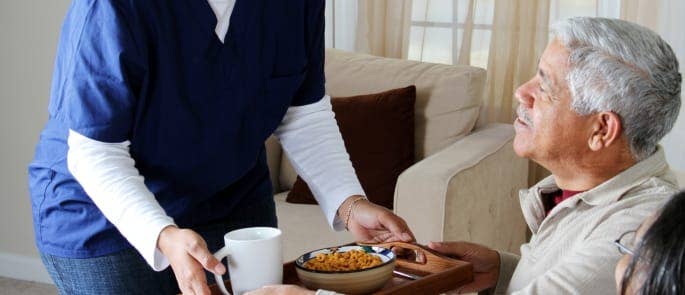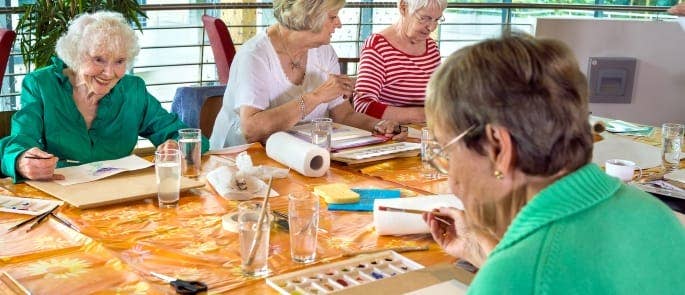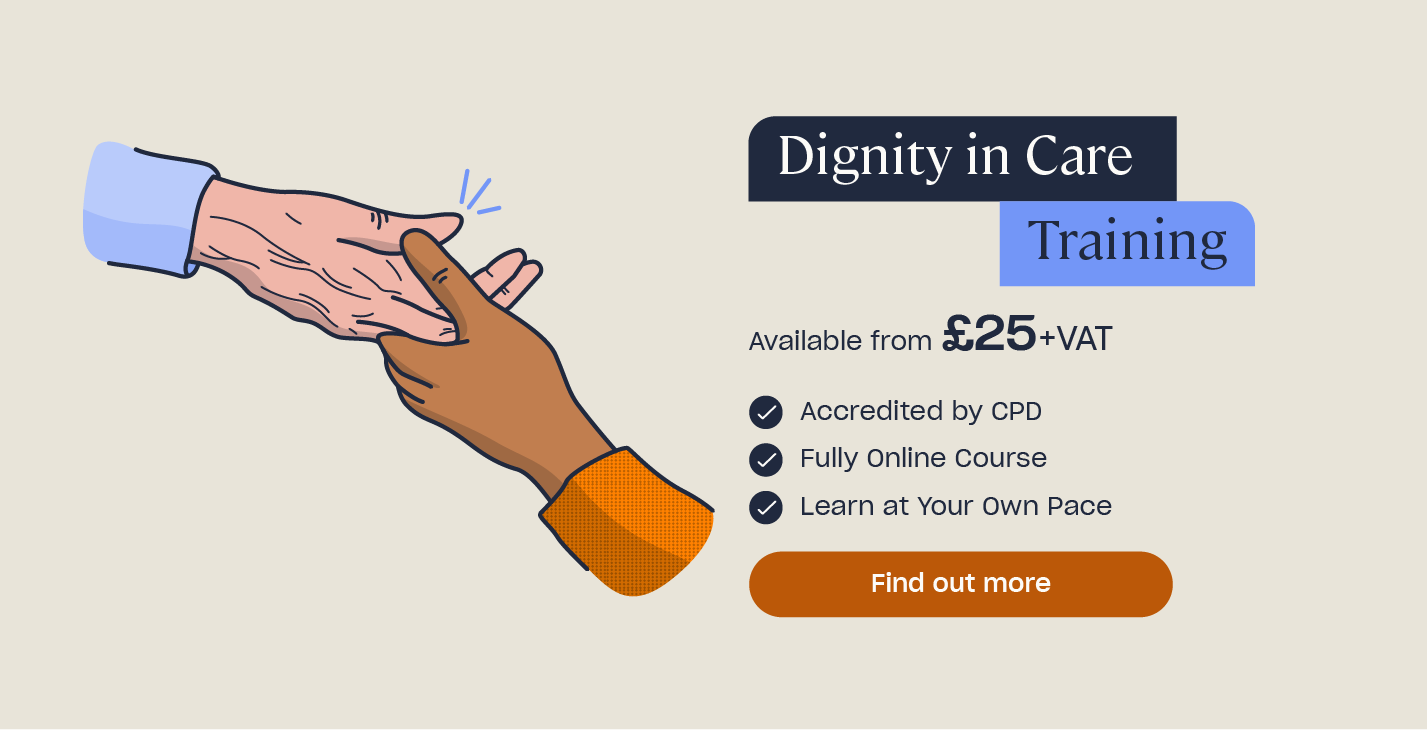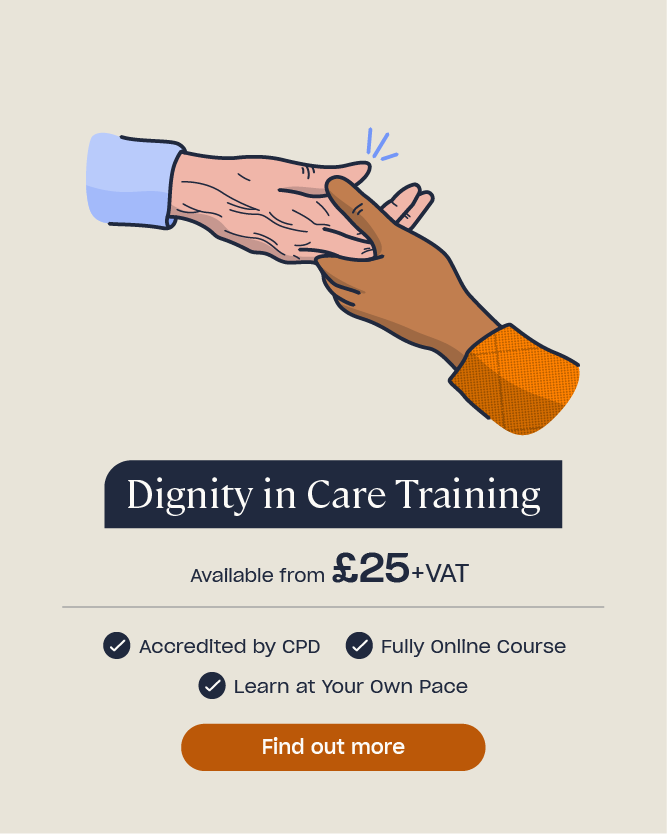9 Ways to Help Promote Dignity in Your Care Home
If people feel their identity and value as a human being is not respected, this can stop them from enjoying life and living comfortably during a period of care.
There are 8 factors related to dignity identified by the Social Care Institute for Excellence:
- Choice and control.
- Communication.
- Eating and nutritional care.
- Pain management.
- Personal hygiene.
- Practical assistance.
- Privacy.
- Social inclusion.
Methods for upholding dignity are usually small, seemingly inconsequential things, but to a person who has resigned the majority of their independence to a stranger, they mean the world.
Need Dignity in Care Training?
Our Dignity in Care Training will give you a strong awareness of how to uphold dignity in a care setting. This knowledge will enable you to care for patients of all ages and from all walks of life in a way that makes them feel secure, comfortable, and, most importantly, valued and respected.
Let’s take a look at 9 examples, all of which derive from the dignity factors listed above.
1. Let people choose their own clothing.
There is nothing more stifling to a person’s identity than having to wear clothes that are not ‘them’. People have a strong sense of what style of clothing suits their personality and personal preferences, so to denying them the ability to choose is harmful to their dignity.

However, this doesn’t mean you can’t assist them. With their approval you can help them dress, but let them pick what to wear. This includes the physical act of choosing. Unless they ask you to, don’t lay out an outfit for them just for the sake of speed. Give them time to select their own from the wardrobe.
2. Involve them in decisions relating to their care.
You might think it’s more straight forward to simply go ahead with decisions about changes to the way people receive care, rather than try explain it to them. But that is harmful to a person’s dignity: it makes them feel disconnected and undervalued. Their lack of control over the situation is dehumanising; they’ll feel like they’re just an object over which you have complete authority.
People appreciate being included as it gives them the sense that their opinion and preferences are respected. Therefore, be sure to involve them in any and all discussions that affect their care. This includes decisions about their medication (e.g. which type to take and how to take it), day-to-day changes (e.g. new staff or changes to the home’s layout), and meal plans (this includes dietary requirements and preferences).
3. Address the person properly.
Another crucial part of a person’s identity is their name – they are how we identify one another. Therefore, making assumptions about which title or name a person would like to be addressed by – even if you think your assumption is the polite choice – is disrespectful to their identity, which in turn damages dignity.
This is particularly important for the elderly, many of whom have certain expectations about how people should refer to them. So always ask a patient how they’d like to be addressed. Similarly, address them with a polite, amiable voice and don’t adopt a patronising tone. They’re adults, not children.
4. Make food look and taste nice.
For people in care – as for many people – mealtimes are the highlight of the day. Nothing is more disheartening than having a lousy lunch. Imagine being presented with an unappetising plate of food – both in terms of look and taste – every day for weeks, months, maybe even years on end.

As mentioned earlier, involve people when creating meal plans – they can offer suggestions, including their favourite dishes. Make sure kitchen staff are skilled at cooking, receive fresh, quality ingredients, and make the effort to ensure food is well-presented.
5. Respect personal space and possessions.
You are caregiver and care resident, not mother and child. Just because you’re in charge of their care, it does not mean you can barge into their personal space without asking for permission. Respecting residents’ privacy in a care home is of utmost importance: being in such close quarters with strangers can already feel claustrophobic without your lack of consideration.
So unless they are incapable of giving permission or it’s an emergency, always knock or ask to come in before entering a person’s room.
Likewise, don’t move or rifle through people’s personal belongings without permission.Even when cleaning, remember to respect their positions and space -ask them if it’s okay for you to move their items while you clean. The simple act of asking makes people feel respected and more open to giving you permission, and instils trust. Be sure to put everything back where it was when you’re done.
6. Handle hygiene activities sensitively.
You may be used to seeing people’s unclothed bodies every day, but the patient will not be used to revealing theirs so frequently. If you need to assist a person with bathing and dressing/undressing, you must handle the situation with tact. Understand that they will be self-conscious and very self-aware when undressed.
Above all, you must ask for consent before you engage in any activities involving their body. Explain what you’re doing as you’re doing it and engage in conversation to make the situation less uncomfortable – having a chat will reduce how hyperaware they are about their body. If they don’t want to talk, ask if they’d like you to put on some music or the TV for background noise.
7. Promote social activities.
Being in a care home can leave a person feeling shut off from the outside world. Particularly for those who have an extroverted personality, this can be extremely stifling and damaging to their identity and dignity. They may end up feeling like they are simply a task for caregivers to complete; like a burden.

Having a social life instils them with a sense of purpose and satisfaction, thus improving their quality of life. So you should take it upon yourself to create opportunities for people in your care to engage in social activities, whether it be inside or outside the premises. Contact with family, eating out with friends, or getting involved in local groups are all good examples. Also, encourage them to adopt hobbies and provide them with the means and equipment to do so, such as knitting or art supplies.
8. Know how to detect pain.
Treating pain in care homes can be tricky. Older people are more likely to experience pain but less likely to complain or want medication. This combination can leave the elderly in a great deal of pain which will distract them and hinder their ability to enjoy the remainder of their life.
Ideally you will be educated on how to identify signs of pain without being told. Restlessness, social isolation, and avoidance are just a few examples. Detecting pain is easier if the person is seen by the same caregiver regularly, since trends and changes in behaviour will be more apparent. It also enables you to build a relationship with the person, so they’ll feel more willing to telling you about any pain.
9. Have a friendly chat.
Your life as a caregiver probably feels very hectic, especially if you have to run back and forth between several people a day. But for a person in care, it could be quite boring or uneventful. You likely talk to dozens of people throughout the day – including other caregivers and service users – but depending on their circumstances, many residents in the care home might only talk to one person a day: you.
A five or ten minute chat will fulfil their craving for social interaction and lift their spirits. Let them lead the conversation if they want to, but don’t just nod along until you have an opportunity to leave. Really listen and interact with them; show interest in what they have to share. When you have to move on, let them know politely and reassure them that you’ll continue the chat next time. And be sure to do so.
Further Resources:
- How to: Promoting Equality & Diversity in Health & Social Care
- Safeguarding Training
- Defining the Different Types of Discrimination in Health and Social Care
- Care Home Risk Assessment: Free Template
- How To Promote Equality & Diversity in Health & Social Care
- Ensuring Human Dignity and Respect in Nursing: A Checklist
- Ergonomic Approach To Manual Handling: Techniques For Carers
- Dignity in Care Training







